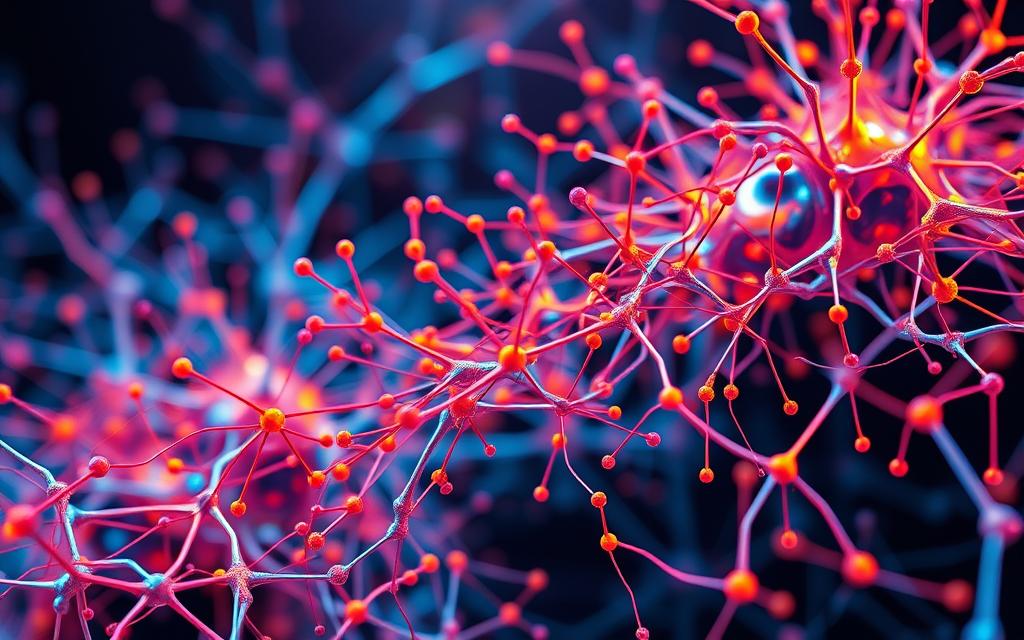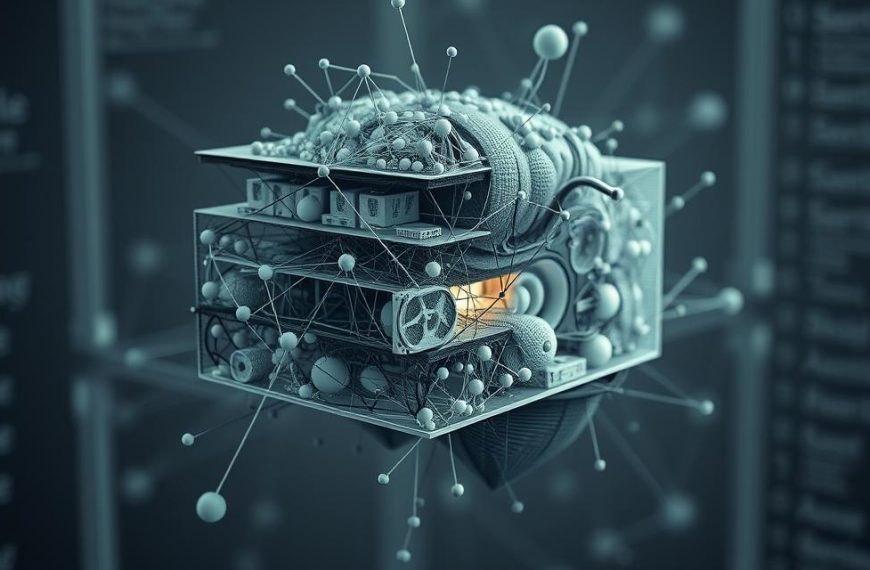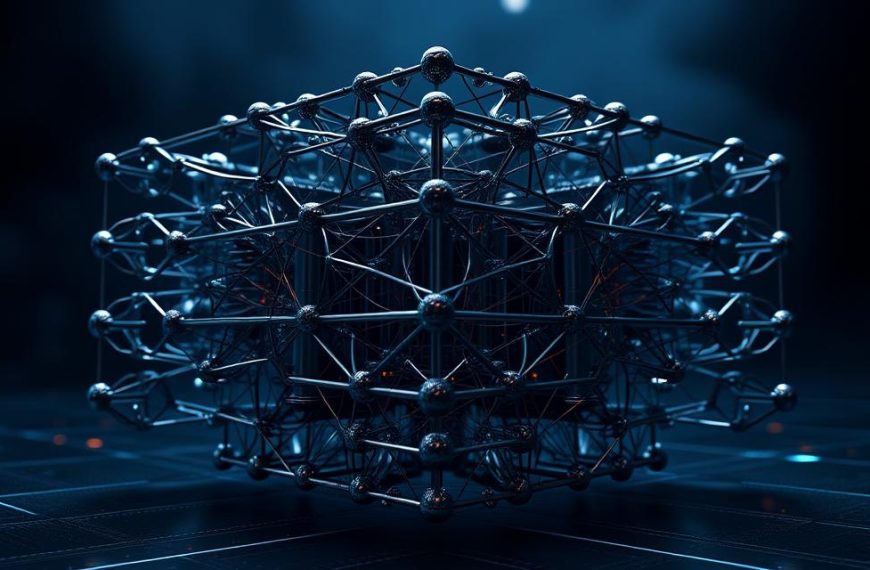In today’s tech-driven workforce, AI literacy is no longer optional—it’s essential. At the heart of modern AI advancements lies the concept of neural networks. These systems, inspired by biological neurons, power innovations like Google’s search algorithm and IBM’s Granite AI models.
Mastering this field requires a blend of theory and practice. Structured learning paths, such as Andrew Ng’s Deep Learning Specialization, provide a solid foundation. Hands-on projects, like coding with TensorFlow or Keras, reinforce conceptual knowledge.
From their inception over 80 years ago to their current applications, neural networks have evolved significantly. Understanding both their biological inspiration and artificial implementation is key to unlocking their potential.
Introduction to Neural Networks
Neural networks have become a cornerstone of modern artificial intelligence. These systems, inspired by the human brain, mimic the way biological neurons process information. By connecting nodes in layers, they enable machines to recognize patterns and make decisions based on data.
What Are Neural Networks?
Neural networks are a type of machine learning model designed to replicate the structure of the human brain. They consist of interconnected nodes, or neurons, that work together to process information. Each node adjusts its behavior based on weights and biases, allowing the system to adapt and improve over time.
Unlike traditional rule-based programming, neural networks excel at handling complex tasks like image recognition and natural language processing. Their ability to learn from data makes them ideal for applications ranging from self-driving cars to medical diagnostics.
Why Are Neural Networks Important?
Neural networks have revolutionized industries by automating decision-making and improving efficiency. For example, speech recognition accuracy has jumped from 70% to 95% since 2010, thanks to advancements in these systems. Google’s BERT model is a prime example of how neural networks have transformed natural language processing.
- Cost savings in industries using automated decision-making.
- Improved accuracy in pattern recognition tasks.
- Widespread adoption, with 78% of enterprises leveraging neural network technology in 2023.
As computational power continues to grow, the potential applications of neural networks are virtually limitless. They are reshaping the future of AI and driving innovation across multiple sectors.
Understanding the Basics of Neural Networks
At the core of AI advancements lies a powerful tool: neural networks. These systems, inspired by the human brain, process information through interconnected nodes. Their ability to adapt and improve makes them essential for tasks like image recognition and natural language processing.
Key Components of Neural Networks
A neural network consists of three main layers: input, hidden, and output. The input layer receives data, the hidden layers process it, and the output layer delivers the final result. Each layer contains nodes that perform calculations and adjust weights based on the data.
For example, in a spam detection system, the input layer receives email features like word frequency. The hidden layers analyze these features, and the output layer determines if the email is spam or not.
How Neural Networks Work
Neural networks operate through a three-stage process: forward propagation, backpropagation, and weight adjustment. During forward propagation, data moves from the input layer to the output layer. Backpropagation calculates errors and adjusts weights to improve accuracy.
“The beauty of neural networks lies in their ability to learn from data and refine their performance over time.”
Here’s a Python code snippet for binary classification using TensorFlow:
import tensorflow as tf
model = tf.keras.Sequential([
tf.keras.layers.Dense(10, activation='relu'),
tf.keras.layers.Dense(1, activation='sigmoid')
])
model.compile(optimizer='adam', loss='binary_crossentropy', metrics=['accuracy'])
| Component | Function |
|---|---|
| Input Layer | Receives data for processing |
| Hidden Layers | Analyze and transform data |
| Output Layer | Delivers the final result |
By understanding these basics, you can appreciate the transformative power of neural networks in AI development.
How to Learn About Neural Networks: A Step-by-Step Guide
Building proficiency in neural networks starts with a clear roadmap. This guide outlines a structured approach to mastering this transformative technology. From foundational concepts to hands-on projects, each step is designed to enhance your understanding and skills.
Start with the Fundamentals
Before diving into complex models, grasp the basics. A strong foundation in linear algebra and calculus is essential. These mathematical principles underpin the algorithms used in neural networks.
Begin with an introduction to machine learning. Understand key concepts like supervised and unsupervised learning. This knowledge will prepare you for more advanced topics like deep learning.
Explore Online Courses and Tutorials
Structured courses are a great way to learn. Platforms like Coursera, Udacity, and edX offer comprehensive programs. Andrew Ng’s Deep Learning Specialization is a popular choice, with modules covering everything from shallow networks to convolutional neural networks (CNNs).
Fast.ai’s curriculum is another excellent resource. It emphasizes hands-on labs, making it ideal for beginners. These courses provide a balance of theory and practical application.
Practice with Real-World Projects
Apply your knowledge through real-world projects. Start with beginner-friendly tasks like MNIST digit recognition. Kaggle offers datasets and competitions to test your skills.
Use tools like TensorFlow and Keras to build models. Cloud services like IBM Watson Studio provide templates and GPU support for efficient training. Completing projects helps solidify your understanding and prepares you for industry challenges.
“The best way to master neural networks is by combining theoretical knowledge with practical experience.”
By following this guide, you’ll gain the expertise needed to excel in the field of neural networks. Start today and unlock the potential of this groundbreaking technology.
Deep Learning vs. Machine Learning: What’s the Difference?
The evolution of AI has brought two dominant approaches to the forefront: deep learning and machine learning. While both are integral to AI development, they differ in complexity, application, and performance. Understanding these distinctions is essential for leveraging their strengths effectively.
Understanding Deep Learning
Deep learning is a subset of machine learning that uses multi-layer networks to process data. These layers enable the system to automatically learn features, eliminating the need for manual feature engineering. For instance, in image recognition, a deep learning model can identify edges, shapes, and textures without explicit programming.
One of the most significant milestones in deep learning was Google’s AlphaGo, which defeated world champions in the complex game of Go. This achievement showcased the power of deep learning in handling unstructured data and making sophisticated decisions.
Comparing Machine Learning and Deep Learning
Machine learning relies on structured data and often requires manual feature extraction. In contrast, deep learning excels with unstructured data, such as images and audio, by automatically identifying patterns. For example, traditional machine learning models like logistic regression use fewer parameters, while deep learning models like ResNet-50 can have millions.
Here’s a comparison of their key aspects:
- Feature Engineering: Manual in machine learning, automatic in deep learning.
- Data Requirements: Deep learning requires large volumes of data for training.
- Computational Power: Deep learning demands significant hardware resources, often leveraging GPUs.
A case study comparing traditional machine learning and convolutional networks (CNNs) for image classification revealed a 20% accuracy improvement with CNNs. This highlights the transformative potential of deep learning in complex tasks.
“The future of AI lies in the convergence of machine learning and deep learning, combining interpretability with scalability.”
As hardware evolves and hybrid systems emerge, the boundaries between these approaches continue to blur, paving the way for innovative AI solutions.
Neural Network Architecture: A Deep Dive
The architecture of neural networks plays a pivotal role in their functionality and efficiency. From simple feedforward designs to complex transformer models, the structure determines how data is processed and analyzed. Understanding these architectures is essential for optimizing performance and solving real-world problems.
Types of Neural Networks
Neural networks come in various forms, each tailored for specific tasks. Here are the most common types:
- Convolutional Neural Networks (CNNs): Ideal for image processing, CNNs use convolutional layers to detect patterns like edges and textures.
- Recurrent Neural Networks (RNNs): Designed for time-series data, RNNs use recurrent connections to process sequences, such as text or audio.
- Generative Adversarial Networks (GANs): These networks generate new data by pitting two models against each other, one creating data and the other evaluating it.
- Transformers: Revolutionizing natural language processing, transformers use attention mechanisms to handle long-range dependencies in text.
Each type has unique strengths, making them suitable for different applications. For example, CNNs excel in image recognition, while transformers dominate in NLP tasks.
Understanding Layers and Nodes
The core of any neural network lies in its layers and nodes. These components work together to process and transform data. Here’s how they function:
- Input Layer: Receives raw data, such as pixel values in an image or words in a sentence.
- Hidden Layers: Perform complex calculations to extract features from the data. Activation patterns in these layers determine the network’s ability to learn.
- Output Layer: Delivers the final result, such as a classification or prediction.
Modern architectures like ResNet introduce innovations like skip connections, which improve training efficiency by allowing gradients to flow directly through layers. Autoencoders, on the other hand, reduce data dimensionality, making them useful for tasks like anomaly detection.
As models grow in complexity, parameter counts have skyrocketed. For instance, the Transformer model has billions of parameters, enabling it to handle intricate NLP tasks with remarkable accuracy. Choosing the right architecture depends on the problem at hand, balancing performance and computational resources.
Practical Applications of Neural Networks
From healthcare to finance, neural networks are transforming industries with their advanced capabilities. These systems are not just theoretical constructs but are actively solving real-world problems. Their ability to process vast amounts of data and identify patterns makes them indispensable in various fields.
Image and Speech Recognition
In healthcare, neural networks are revolutionizing diagnostics. Convolutional Neural Networks (CNNs) are now FDA-approved for detecting tumors in medical imaging. These systems analyze radiology scans with precision, reducing human error and improving patient outcomes.
Speech recognition has also seen significant advancements. Alexa’s pipeline, powered by deep learning, has achieved a Word Error Rate (WER) improvement from 23% in 2013 to just 5% in 2023. This leap in accuracy has made voice assistants more reliable and widely adopted.
Natural Language Processing
Natural language processing (NLP) is another area where neural networks excel. The BERT model, for instance, has set new benchmarks on the GLUE dataset, achieving state-of-the-art performance in tasks like sentiment analysis and question answering. Its transformer architecture allows it to understand context and nuances in text.
Real-time translation systems, such as those used by Google Translate, rely on neural networks to provide accurate and instantaneous translations. These systems break down language barriers, enabling seamless communication across the globe.
“Neural networks are not just tools; they are catalysts for innovation, driving progress in ways we could only imagine a decade ago.”
Other notable applications include:
- Fraud detection in financial transactions, where neural networks identify suspicious patterns in real-time.
- Recommendation systems in e-commerce, which personalize user experiences by predicting preferences.
- Autonomous vehicle perception systems, enabling cars to navigate complex environments safely.
- Energy savings in smart grid systems, optimizing power distribution based on demand.
- Accelerating drug discovery by predicting molecular interactions.
- Ethical considerations in facial recognition, ensuring responsible use of technology.
These examples highlight the versatility and transformative potential of neural networks. As technology evolves, their applications will continue to expand, shaping the future of multiple industries.
Resources for Learning Neural Networks
Mastering neural networks requires access to the right resources and tools. Whether you’re a beginner or an advanced practitioner, curated materials can accelerate your understanding and application of this transformative technology.
Recommended Books and Articles
Books like Deep Learning with Python by François Chollet provide a hands-on approach to building and training models. For a theoretical foundation, Ian Goodfellow’s Deep Learning textbook is widely adopted in academic and professional circles.
Research papers on arXiv offer cutting-edge insights. The platform has seen a 30% growth in submissions since 2020, reflecting the rapid advancements in the field. Industry blogs from Google AI and OpenAI are also invaluable for staying updated on trends and breakthroughs.
Top Online Courses and Certifications
Structured courses are essential for systematic learning. Andrew Ng’s Deep Learning Specialization on Coursera has a 90% completion rate, making it a popular choice. Fast.ai’s practical approach is ideal for those who prefer hands-on labs over theoretical lectures.
Cloud platform certifications, such as AWS Machine Learning and Azure AI Engineer, are highly sought after. These programs validate your skills and prepare you for industry challenges. Here’s a comparison of key certifications:
| Certification | Platform | Focus Area |
|---|---|---|
| AWS Machine Learning | Amazon Web Services | Machine Learning |
| Azure AI Engineer | Microsoft Azure | AI Development |
| Google Cloud AI | Google Cloud | AI and ML Models |
For those interested in open-source frameworks, PyTorch and TensorFlow tutorials are essential. These tools are widely used in both research and industry, making them critical for building and deploying models.
“The right resources can transform your understanding of neural networks, turning complex concepts into actionable knowledge.”
Attending conferences like NeurIPS and ICML provides networking opportunities and exposure to the latest research. Debugging tools such as TensorBoard and Weights & Biases streamline the development process, while hardware configurations tailored for home labs ensure efficient training.
Common Challenges in Learning Neural Networks
Mastering neural networks often comes with its own set of hurdles. From grappling with mathematical complexity to addressing data limitations, learners face unique obstacles. Understanding these challenges is the first step toward overcoming them.
Overcoming the Complexity
One of the most common problems is the steep learning curve. The mathematical foundations, such as linear algebra and calculus, can be intimidating. Visualization tools like TensorBoard simplify these concepts by providing graphical representations of model performance.
Progressive learning pathways also help. Start with basic models like linear regression before advancing to convolutional neural networks (CNNs). This step-by-step approach builds confidence and deepens understanding.
“Breaking down complex concepts into manageable steps is key to mastering neural networks.”
Dealing with Data Limitations
High-quality data is essential for effective training. However, datasets are often imbalanced or insufficient. Data augmentation techniques, such as flipping images or adding noise, can enhance dataset diversity. Synthetic data generation is another powerful solution, creating artificial datasets that mimic real-world scenarios.
Ethical considerations are equally important. Ensuring responsible data sourcing and privacy-preserving methods is critical. Here’s a comparison of popular data labeling platforms:
| Platform | Features | Pricing |
|---|---|---|
| Labelbox | Collaborative labeling, API integration | Starts at $49/month |
| SuperAnnotate | AI-assisted labeling, project management | Custom pricing |
| Scale AI | High-quality annotations, enterprise support | Contact for quote |
Cloud-based solutions like AWS SageMaker and Google Cloud AI Platform address resource constraints. These platforms provide scalable power for training models, making them accessible to learners with limited hardware.
By addressing these challenges, you can unlock the full potential of neural networks and apply them effectively in real-world scenarios.
Future Trends in Neural Networks
The future of neural networks is shaped by groundbreaking innovations and emerging technologies. From neuromorphic computing to quantum machine learning, these advancements are redefining the possibilities of artificial intelligence. As research accelerates, the integration of deep learning with cutting-edge hardware is unlocking new frontiers.
Emerging Technologies
Neuromorphic computing is one of the most promising areas of research. By mimicking the structure of the human brain, this technology offers significant speed and efficiency improvements. Quantum machine learning is another frontier, with projections suggesting it could accelerate training times exponentially.
Edge AI is also gaining traction, enabling real-time processing on devices like smartphones and IoT sensors. This reduces latency and enhances privacy, making it ideal for applications like autonomous vehicles and smart cities. Federated learning is another key trend, allowing models to be trained across decentralized devices without compromising data security.
The Role of Neural Networks in AI Development
Neural networks are at the heart of AI’s evolution. Their ability to process complex data and adapt to new challenges makes them indispensable. Innovations like energy-efficient architectures and multimodal models are pushing the boundaries of what AI can achieve.
For example, brain-computer interfaces are integrating neural networks to enable direct communication between the brain and external devices. This has profound implications for healthcare and accessibility. Similarly, synthetic neural networks are being explored to create more robust and scalable AI systems.
“The convergence of neural networks with emerging technologies is driving a new era of AI innovation.”
As these trends evolve, the role of neural networks in shaping the future of AI will only grow. For a deeper dive into these advancements, explore this comprehensive resource.
Conclusion
The journey into mastering neural networks is both challenging and rewarding. From foundational concepts to hands-on projects, each step builds your expertise in this transformative field. These systems are reshaping industries, enabling groundbreaking applications in healthcare, finance, and beyond.
Continuous skill development is essential. Engage with community resources, online courses, and real-world projects to stay ahead. Ethical implementation ensures that these technologies benefit society responsibly.
As the future of AI unfolds, your role in innovation becomes critical. Start today, explore hands-on opportunities, and contribute to the democratization of AI development. The possibilities are limitless, and your journey is just beginning.
















